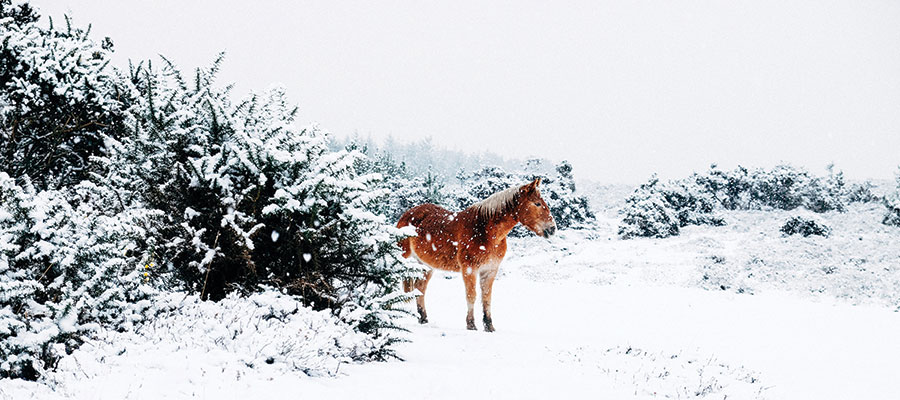By Daniel H. Grove, DVM

Horses are extremely good at dealing with a drop in temperature. I have driven through snow-filled states in temperatures in the teens and watched horses happily walking through the snow without a care in the world, no shivering or any other sign of a low body temperature. I have been in Southern California when it was 50° F out and I have full-grown adult mares coming into the barn to be palpated—and they were shivering like no tomorrow. What is the difference? Mostly, human management! Yes, there are certain circumstances where an individual may not be capable of proper thermoregulation without human interference, but by and large, with a little help, they can usually do it very well on their own.
There are two things humans commonly do that decrease our horses ability to thermoregulate properly. Both of them involve the hair coat of the horse. The hair coat traps in air between it and the skin. This is similar to how the fiberglass insulation in the walls of your house work. This trapped air does not conduct heat well, so it acts as an insulator. There are other factors that go into the body’s changes for winter, but for the human factor, this sums it up well.
The first thing people do to decrease the hair coat is body clipping. We want our horse to look clean cut and slick. During winter they get more like my beard, long and scruffy. Removing a significant amount of the winter coat simply decreases the amount of hair to protect and insulate the horse. Without this, the horse has to find other ways to make up for the increased heat loss.
The second thing we do that affects the hair coat is having our horses under artificial lighting in the winter. Hair growth in the horse is regulated via melatonin. Melatonin is regulated via a tiny little gland called the pineal gland. The pineal gland responds to light. In times of more light, the pineal glands secretes less melatonin. When there is less light, the pineal gland secretes more (All of our insomniacs maybe understand why we take melatonin a little bit more now!). So this corresponds to day length for the horse. During summer, we have hot days and long days. The hair coat is naturally very short. In the winter, we have shorter days and longer nights. This translates to longer hair coats. As you can see, horses and many other animals, have developed a very nice system to help their bodies change along with the weather. When we hinder this natural process with artificial lighting, we take away the cue to the body to get ready for cold.
No matter what I say here, I know many of you participating in these practices are going to continue. I do quite a bit of reproductive work and it is important to have our stallions and mares under lights in preparation for our desired time for breeding season. So how do we help these animals? The first thing you can do is what you would do for yourselves—put a jacket on. A nice winter blanket can really help keep your horse warm. Next, provide shelter. A nice barn, mare motel or even a pasture shelter, even with a wall or two can make a big difference. Lastly, keep them dry. The water from bathing or rain mixed with the decreased coat can drop their body temperatures quickly. Those mares I see shivering at 50°F are coming in from the rain with slicked out hair coats. Just keeping them dry makes a big difference.
Hopefully I have given you some ideas on how to continue your desired care of your horse and yet keep them warm. Happy Holidays everyone! We will talk next year.
–Dan
Leave a Comment
All fields must be filled in to leave a message.